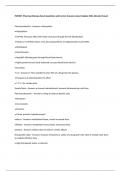PMHNP- Pharmacotherapy Exam Questions and Correct Answers Latest Update 2024 Already Passed
Pharmacokinetics - Answers • Absorption
• Metabolism
• CYP450, first pass effect (PO meds must pass through liver bf distribution)
• Tobacco is CYP450 inducer, thus decreasing effects of antipsychotics by 20-100%
• Distribution
• Psychotropics
o lipophilic allowing pass through blood brain barrier
o highly protein bound (only unbound can pass blood brain barrier)
• Excretion
T 1/2 - Answers • Time needed to clear 50% of a drug from the plasma
• Frequency of administration for effect
• 5 T ½ s for steady state
Steady State - Answers • Amount administered= amount eliminated per unit time
Pharmacodynamics - Answers o Drug to body at specific sites
• Receptors
• Ion channels
• Enzymes
• Carrier proteins (uptake pumps)
inducer - Answers metabolized faster, needs increased dose
inhibitor - Answers metabolized more slowly, decreased dose
potency - Answers relative dose to achieve certain effects
therapeutic index - Answers measure of toxicity or safety of a drug and is the ratio of median toxic dose
to median effective dose
o High therapeutic index- ie lamictal
, o Low therapeutic index- ie lithium
tolerance - Answers becoming less responsive to a particular drug as it is administered over time
dopamine - Answers Schizophrenia, drug addiction, ADHD
Abnormal thalamic function, stimulation sensory cortical area, impaired cortical associations
norepi - Answers Anxiety, ADHD, Depression, Addiction
Modulation of stress, autonomic response, attention, memory, mood
serotonin - Answers Depression, Anxiety, Addiction, Schizophrenia
Modulation of arousal, feeding, aggression, pain, circadian rhythm, neuroendocrine function, enhances
dopamine cell functioning
acetylcholine - Answers ADD, ADHD, DAT
Attention, memory, mediated by nicotinic and muscarinic (cholinergic)
Glutamate - Answers Cognitive Dos, CVA, epilepsy, addiction, bipolar, DAT
Major excitatory neurotransmitters, learning, memory, cognition, development of synaptic plasticity
GABA - Answers Depression, anxiety, addiction, schizophrenia
Major inhibitory NT, modulation of arousal, feeding, aggression, pain, circadian rhythm, neuroendocrine
function, enhances DA cell firing
adenosine - Answers ETOH drug addiction, high metabolic state (MI, fever, infection)
Produced during increased metabolic activity and ischemia for neuroprotection
Antagonists: (caffeine) mediate motor-stimulant effects
Agonists: hypnotic, anxiolytic, motor-suppressants effects and inhibit actions of abuse and ETOH
neuropeptides - Answers Endocrine most d/os
Similar function to NT, ie endogenous opioids such as enkephalins, endocrine modulation
positive s/s schizophrenia - Answers increased DA in Mesolimbic
Limbic system
negative s/s schizophrenia - Answers decreased DA Mesocortical




